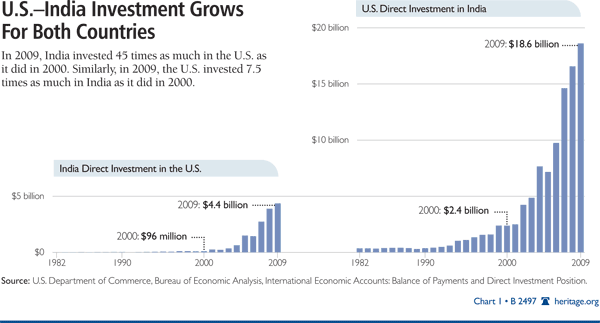Abstract: India has almost unmatched economic potential, but neither its prosperity nor its globalization are assured. India will realize one of four basic scenarios depending chiefly on the extent to which it reforms property rights and improves primary and secondary education. The best scenario is for India to move forward on both property rights and education, which will lead to successful globalization. Indian states as well as the federal government will determine the outcome. The U.S. can facilitate Indian globalization by encouraging clear property rights, cooperating in improving education, and expanding mutual market access. It should do so because a successful, globalized India will be a better market and better international partner for the U.S.
Most economic analysis of India emphasizes its long-term potential, which raises the obvious question of when India will realize that potential. From the U.S. perspective, the faster India becomes prosperous, the more the U.S. will benefit.
Almost as important is India’s international economic orientation. India’s days of bizarre economic nationalism seem to have ended, but the nature and extent of the country’s economic relations with the world are still undecided. What will Indian globalization look like? In addition to the economy’s size and wealth, the extent of its globalization will have implications for American policy.
While it has drawbacks, more Indian economic globalization is better for the U.S. and should be supported. For example, an India that is neither especially global nor especially dynamic would undermine incentives on both sides of U.S.–India relations and threaten a return to the long stagnation in the relationship. At the other end of the spectrum, a globalized, much richer India could be one of America’s most important international partners.
This paper sketches four simple scenarios for India’s globalization that emphasize its economic relations with the rest of the world as much as or more than conventional measures of domestic development.
The paper also indicates how the U.S. can encourage Indian globalization. It should move decisively to engage Indian states, not just the federal government. At both the federal and state levels, American policy should have two main dimensions: (1) enhancing cooperation in property rights and investment access, chiefly to reduce or circumvent Indian statism, and (2) protecting existing cooperation in goods, services, and labor trade, chiefly to avoid American protectionism.
Globalization Scenarios
American policymakers should consider four possible scenarios for Indian economic development:
- Relative isolation and relative failure,
- Relative isolation and relative success,
- Unsuccessful globalization, and
- Successful globalization.
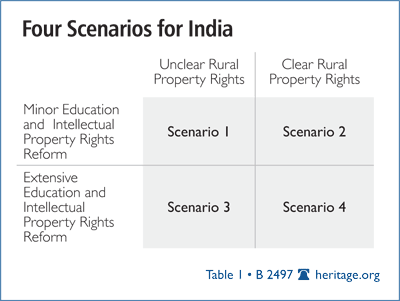
Globalization and success are clearly related, as countries that globalize are far more economically successful than those that do not. South Korea and North Korea are textbook examples. Nonetheless, globalization offers no guarantees. It has economic and, especially, political pitfalls.
These four scenarios are quite simple in nature, but the various assets involved in globalization— goods, services, capital, technology, and people— can lead to widely divergent outcomes. The movements of these assets are driven by an economy’s “endowment“—how much labor, capital, and physical resources it has in comparison with the rest of the world, or what the economy has to offer and what it needs. Policy preferences expressed by national governments, such as moving beyond simple goods and capital liberalization to more comprehensive globalization based on technology, are relevant, but not as important as endowment.
India obviously has a great deal of labor, while its physical resources are largely inadequate given the size of its population. Water is the most glaring example. India is presently inadequately endowed with capital, but that could change more quickly than its labor and land endowments.[1] In contrast, America has bountiful capital and land resources and therefore an immediately complementary economic connection to India.
Because India is comparatively labor rich, it should export goods, services, and labor to its economic partners while importing capital and technology. Imports of capital and technology match these expectations, as do exports of labor and, to some extent, services. However, net service exports are slightly underdeveloped given the size of the labor force, and India has a large deficit in goods trade.[2] The main reason for these deviations is that a majority of Indian labor is trapped in low-productivity farm work, limiting exports of goods and services.[3] This, in turn, threatens domestic support for globalization and limits the U.S.–India partnership.
Scenario 1. It is not a given that India will globalize or continue its rise. Economic development is not the product of history and certainly not “destiny.” It is the product of policy. After more than four decades of bad policy, India moved toward a market economy in 1991, and more successful development ensued. However, the reform that triggered the current wave of optimism is nearly 20 years old, and fiscal irresponsibility in the name of populism has largely replaced liberalization.[4] If bad policies continue, India’s anticipated successes will evaporate.
Further, democracies require especially strong leadership to maintain commitments to open international markets, and such leadership may be lacking in India. Of course, the trends are related. India’s present acceptance of globalization is largely due to its new competitive confidence. If this confidence fades, the acceptance of globalization will likely also fade.
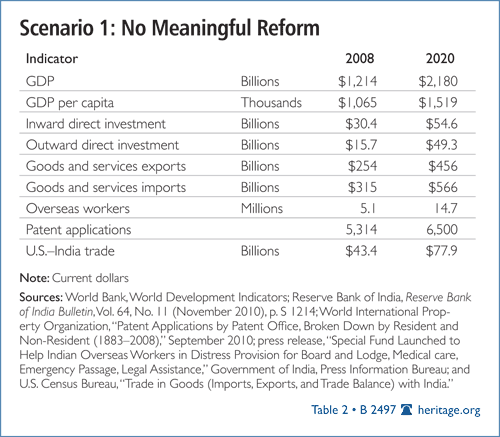
There is evidence of continued strong Indian opposition to globalization.[5] India is widely acknowledged as the chief obstacle to a World Trade Organization agreement on agriculture trade in late 2008. Foreign investment access to many sectors, especially retail, remains sharply limited.[6] Both of these positions are presumably motivated by employment concerns. Recent actions have explicitly targeted foreign labor.[7] In 2010, India began targeting the property rights of foreign technology companies in the name of security, adding to alleged Indian infringements of many patents.[8] India has also adopted a number of steps aimed at China, across all dimensions of economic exchange.[9]
Challenges from jobs, security, and China are unlikely to fade for some time. As demographic expansion progresses, labor pressures could become an especially daunting political force pushing for economic isolation. India is also large enough that predatory behavior in property rights could prompt coordinated multilateral retaliation.
Changes that would yield this scenario are easy to anticipate because India retains the option of reverting to its pre-reform policies. The state owns all land, most banks, and a broad array of public enterprises. India still has five-year plans and other elements of a command economy.[10] Ignoring the state’s development record and misreading the growth–infrastructure relationship, the government maintains the explicit goal of siphoning $1 trillion into state-led infrastructure programs.[11] Federal and state governments could use increasing economic control to fight off the supposed injustices of globalization, sacrificing growth and technological advancement for stable employment.
The extent of the commitment to globalization is best exemplified by acceptance of intellectual property and other rules governing technology trade. While using Indian law to infringe on the property rights of foreign technology companies might yield positive results in the short term, it harms the economy as a whole by blocking the many benefits of globalization, preventing the emergence of Scenario 3 or Scenario 4.[12] Rejection of technology ownership also makes development failure likely, explaining why Scenario 1 is more likely than Scenario 2.
Lack of capital movement is a particularly clear marker for Scenario 1. A xenophobic India, seen as recently as the late 1980s, blindly rejects capital inflows and fears capital outflows. Therefore, Scenario 1 is the most likely to obtain when property rights in technology are ignored and when capital movement is restricted.
In Scenario 1, U.S.–India relations will most likely return to their state during the first 40 years of independence. As economic prospects fade, India will return to being inward-looking or, at best, regionally oriented. Globalization will be blamed for causing slow development. It is easy to imagine an India that lays claim to leadership of the anti-globalization movement, and the U.S. would have little interest in such a partner.
Scenario 2. History indicates some degree of economic globalization is inevitable over time, but its pace and intensity are not inevitable. Some countries have isolated themselves from the process, albeit at high cost. Post-independence India has shown strong distrust of external influences, and it could conceivably reject globalization’s sometimes wrenching dislocations. Already, much Indian economic policy is devoted to shielding a labor-intensive, low-productivity agriculture sector from competition.[13] Rather than causing an outright reversal, such policies are more likely to cause trade and capital inflows to stall, leaving India effectively more closed over time compared with its economic peers.
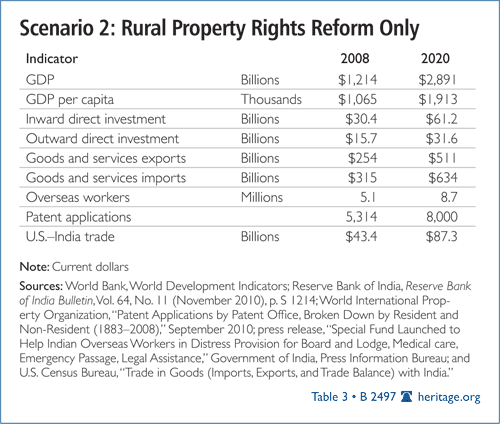
Very few economies could thrive in relative isolation from the international economy, but India may be one of them. The domestic market is already large enough that external demand is not absolutely necessary. Indeed, India runs a very large trade deficit on excess internal demand. Labor will certainly not be in demand for the indefinite future.
Challenges will come on two main dimensions:
- Physical resources, such as arable land and water, and
- Capital and technology.
Even a fairly isolated country can acquire technology if it can afford it, but India does not yet generate enough domestic capital. More daunting will be supporting a wealthier population. Meeting the demands for food and energy will become increasingly difficult without large-scale imports. An India that rejects broad globalization must carefully manage trade channels to draw needed resources. Globalization in this scenario is limited to a narrow range of goods and technologies, while other goods and technology, capital, labor, and services must be tightly restricted.
Encouraging capital formation and efficient use of resources will require intense economic reform at the national and state levels. The successful development, which distinguishes successful Scenarios 2 and 4 from failure Scenarios 1 and 3, primarily depends on establishing clearer property rights in rural areas. India could address the jobs and resource issues by assigning clear rural property rights, which encourage efficient use.[14]
Rural property rights will drastically raise agricultural productivity and income and permit large-scale migration into manufacturing. Wages are higher in manufacturing than in agriculture, and better farm productivity will restrain or reduce food prices. Real incomes will rise markedly if the return to land rises.[15] However, clear property rights are not enough to spur exports by themselves because they cannot make Indian manufacturing globally competitive. Without job creation from exports, domestic political support for globalization will remain limited, ruling out Scenarios 3 and 4.
Thus, the status of rural property rights signals whether Scenario 1 or Scenario 2—failure or success without globalization—is more likely. Beyond the utilization of labor, capital exports will remain limited, due either to fears of flight or to foreign rejection of Indian outward investment, which naturally harms globalization sentiment.
A successful, but mostly isolated India will likely have a positive, but limited relationship with the U.S. The U.S. and India may have little cause for disagreement, but without a compelling economic motive to engage the world at a high level, India will be unwilling to take controversial or costly actions in pursuit of larger international objectives.
Scenario 3. Globalization may not be inevitable, but it is likely. The simple argument in favor of Scenarios 3 and 4 over Scenarios 1 and 2 is that they merely continue current trends. India is already a major importer of goods, with a current account deficit near 4 percent of GDP, and it is financing this deficit with increasing inflows of portfolio capital.[16] It is negotiating multiple, if limited, free trade agreements.[17] These are all strong indicators of political and economic openness.
However, India’s economic rise is also at issue. While it seems unintuitive for globalization to proceed even while the development process is slow and marred, banking provides a telling example. The Reserve Bank of India has remarked that coordination with other central banks is fine, while internal financial intermediation is poor. India could succeed in attracting foreign capital to its state-led infrastructure program until the program’s stark failings become obvious.[18] Graft is an obvious threat in such a large government initiative.
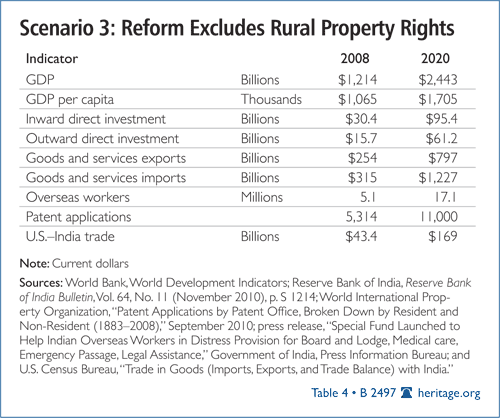
In Scenario 3, the needs for foreign food, energy, technology, and capital drive globalization. Workers and students continue to look overseas, but largely as a function of inadequate opportunities at home. The federal and many state governments choose decisively interventionist internal policies, which fail but are defended politically as offsetting the unavoidable and harmful impact of globalization.[19]
The present federal government is following one version of this path, bizarrely running large budget deficits and sharply negative real interest rates despite high growth, ostensibly for the sake of the common man. The unsurprising outcome has been high inflation, which robs most of the poor and many others of the seemingly large income gains from rapid growth. High growth and inflation simultaneously create a larger global footprint from raw size, but do not bring prosperity.[20]
While this scenario includes considerable globalization, flaws in the domestic economy induce unavoidable limitations. Capital imports are accepted, but capital exports are effectively limited due to funding amounts that are progressively less competitive. Domestic failure will also naturally reduce the ability to pay for foreign technology. Labor is traded, but persistent large-scale labor exports are a sign of inadequate prospects at home, and development failures limit labor imports on economic grounds.
Sustained increases in goods and services exports are obviously a core element of globalization. Demographic expansion lends itself to such gains, but other factors do not. In agriculture, state ownership of land induces rural poverty and cannot be cured by globalization. Primary and secondary education needs to improve considerably before Indian manufacturing, much less services, can be competitive.[21] If secondary education improves, but rural property rights do not, India would be competitive in services, but not in goods because farming will still absorb the bulk of the workforce. Globalization would be extensive on multiple dimensions, yet development would be stunted.
A globalized, but not very successful India will likely have a contentious relationship with the U.S. Conflicts over market access will arise, with India possibly demanding unbalanced access and technology transfers. The U.S. and India will also clash over use of international resources and environmental issues. The bilateral economic relationship will be fairly intense, but always rocky, and the U.S. will see more pain than gain from this India.
Scenario 4. The ideal outcome is an India that both globalizes and thrives. For this to occur, the ongoing demographic expansion must be used properly. This requires clearer property rights to land, which will rapidly increase rural incomes and agricultural productivity and free up labor for urban areas. Much better primary and secondary education of these ex-farmers and rural workers is then necessary. Finally, open and flexible markets will absorb the new workers and match them to the right jobs.[22]
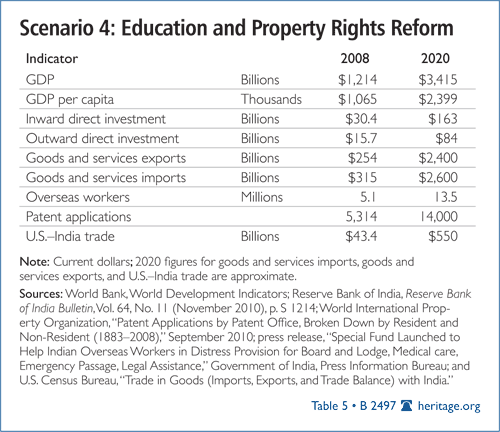
If India can overcome these challenges, it will have so much to offer the world in terms of a huge, productive labor force that globalization will be the obvious choice for both the country and its partners. Domestic objections will fade in the face of the obvious benefits from globalization and even sensitive areas, such as retail, will be opened to competition. Exports of labor-intensive goods and services will soar, balancing India’s high-demand economy. As with other globalization experiences, low-end manufacturing will become more prominent, but India will also boast selected exports of services.
Two-way labor movement is a powerful signal of globalization. Export of labor will continue, but increasingly become a luxury, because India will be able to employ more labor at home. International willingness to accept Indian workers will remain an important factor in maintaining domestic support for globalization, providing political cover for elected officials. A key sign of popular domestic support will be a willingness to accept modest labor imports, which will also depend on the flexibility of local labor markets.
An India that has taken difficult steps to improve its labor force will naturally desire capital inflows to complement that labor force. Foreign capital and technology will flow in to share Indian production and growth, and domestic capital will flow out seeking technology and materials to enable production. In addition, development success breeds tolerance of property rights, which in turn breeds development success—a virtuous circle making Scenario 4 more likely than Scenario 3. In terms of sectors, telecommunications and the power sector will smooth the globalization process by offering especially large benefits to both sides of domestic–foreign partnerships.[23]
This India will be a genuinely global economy and at least fourth largest in the world. This will naturally provoke some tension with the U.S., but the Indian and American economies will be complementary. The U.S. will trade technology and capital for Indian goods and services, helping both economies and most likely in sustainable fashion because both are demand-driven. While development and other differences make it unlikely that India will become America’s closest partner, its economic size, global orientation, and rapid expansion in this scenario might make it the most important.
States: Vital and Understudied
India’s potential importance is growing faster than the ability to assess its direction. This is most apparent in Indian states. Indian globalization is at least as much regional as it is national. It will be driven by state policies as much as by federal policy. Indian states have wildly different endowments of land, labor, and capital. They are governed by extremely different political parties, which often adopt a stunning variety of economic strategies. The variations make it difficult to be a true India economist, rather than a regional economist.
While evaluation is constrained by the incomplete data, certain states are plainly farther along in the globalization process than others.[24] Indian globalization will ultimately progress according to the examples of the most prominent leading and lagging states. If Gujarat, Tamil Nadu, and states with similar policies are clearly successful, they will be imitated. If they are obviously struggling, globalization will be politically repudiated.
At the other end of the spectrum, if Orissa and others do comparatively well, the pressure for globalization will weaken. If they are suffering, it will increase. At times, the situation may seem chaotic, with some states actively globalizing while others are actively hostile, but such a situation will not last. Development success of the states pursuing the most effective globalization policies will be a clear signal as to whether India is moving toward closed Scenarios 1 and 2 or open Scenarios 3 and 4.
To the extent that India does globalize, variations in endowments and policies among states will create sharply different patterns in terms of goods, services, capital, technology, and people. All states will engage in heavy trade in goods, but its composition and trade balances will be entirely different, as will the remaining trade restrictions. Similarly, all states will import services, but of different types and with different restrictions. Only a few states will actually export services. All states will need capital imports, but some will balk at “excessive” foreign ownership. Only a few will export capital. All will need technology, but treatment of property rights will diverge. Many, but not all, will export labor.
States are vital in a second way: Long-term national development success requires greater integration among the states.[25] This is especially true in a democracy, in which increasing regional gaps cause political fissures and can paralyze policymaking.
States often block each other’s agricultural products and investments, especially in land. Their regulations conflict across a wide range of areas. Landmark reform of goods and services taxes has foundered on the desire of states to keep their own, disparate systems.[26] Electricity is not even freely transferred across most state borders. Integration among states would remove barriers to economic activity, boosting economic growth at little cost. Such integration will go a long way in moving India from the unpleasant Scenarios 1 and 3 to the preferable Scenarios 2 and 4.
U.S. Policy Recommendations
The scenario descriptions flesh out the obvious conclusion that successful Indian globalization is the ideal outcome for the U.S. They also suggest that unsuccessful Indian globalization may be the worst outcome for the U.S. This implies, not surprisingly, that the decisive factor is whether Indian development itself succeeds. The U.S. has limited influence over internal Indian policy, much less the development of such a huge economy.
India’s commitment to difficult market-oriented reform, which pushed it far past the “Hindu rate of growth,” has faded somewhat, and America needs to join with domestic Indian interests to resist re-expansion of the state, presently through the state-led infrastructure program. While the U.S. cannot play a decisive role, it can perhaps encourage a partial rollback of state prerogatives in determining infrastructure projects. Perhaps the most important factor in ensuring successful Indian economic development is to clarify rural property rights. The U.S. needs to seek ways to assist in this process.
Such actions will help to prevent realization of the unpleasant Scenarios 1 and 3. To encourage Scenario 4, the U.S. should promote Indian globalization. Because this has bilateral components, American policy can be more effective.
The principal change needed to globalize the whole Indian economy is to improve primary and secondary education. Tertiary education is valuable, but by itself will bring only a small portion of the labor force into the world marketplace. The U.S. should consider resources requested by India for primary and secondary education a very worthwhile investment in facilitating Indian globalization. The U.S. should also begin to encourage Indian economic globalization at the state level. While state policy preferences vary widely, nearly all states will be interested in some form of mutual cooperation.
In promoting globalization, American policy should balance offense and defense. In goods, services, and labor, the U.S. should preserve open exchange. India runs a large deficit in goods trade and is not a predatory partner. The composition of goods trade is also suggestive. The leading American import in 2009 was gems and the top export was aircraft.[27] In services, India offers unmatched opportunities to American firms. The key to expanding the U.S. share of potentially huge Indian demand for goods and services is simply to maintain the long-time U.S. commitment to open markets, including an open door for Indian workers. This plainly precludes restrictions on outsourcing.
In contrast, the U.S. needs to press India on capital and technology movement. Less self-serving Indian behavior in foreign property rights (e.g., in pharmaceuticals) will benefit India in the long term and is critical for the U.S. to gain from Indian globalization.[28] Indian business groups correctly note that Indian investment in the U.S. is rising. Indian greenfield investments in the U.S. exceeded $5 billion from 2004 to 2009 and have accelerated this year, featuring increasingly prized resource acquisitions.[29] Reciprocal access is now a powerful argument to open Indian markets further to U.S. investment—one American policymakers should emphasize.
In this situation, the U.S. should:
- Promote contacts between Indian states and American corporations, state governments, and education groups. The Departments of State and Commerce should initiate these efforts.
- Reorient the existing Agricultural Knowledge Initiative to feature property rights clarification as one of its main objectives. On the U.S. side, the Department of Agriculture should coordinate this effort, offering American technical and financial assistance, such as satellite mapping of the millions of possible land boundaries.
- Establish a forum for primary and secondary educators, akin to the existing forum for chief executive officers. The forum should include public and private educators and introduce U.S. education groups to private Indian education entities. It should consider supplying U.S. education technology and boosting programs such as Teach for America’s Teach for India, which might be used to help create a teacher certification process.[30]
- Focus existing bilateral dialogues and initiatives more narrowly on mutual market access and cooperative innovation to encourage Indian globalization. President Barack Obama laid out these goals during his November visit. American participation in the more focused dialogues should include the private sector; the Departments of Commerce, Treasury, Labor, and State; and relevant technology offices in other departments.[31]
- Refrain from unilateral intervention in U.S.– India commerce, such as recent congressional action targeting Indian labor.[32]
Conclusion
Indian development is a necessarily chaotic process. Additional complications from economic relations with another large democracy create still more confusion, but the possible payoffs from the U.S.– India economic relationship should help to establish priorities.
If India can successfully develop and globalize, it has the potential to become one of America’s most important international partners. That prize, rather than current political or bureaucratic imperatives on either side, should dictate American policy. The pathways to the prize are encouraging better Indian property rights, education, and bilateral market access to goods, services, capital, and labor at both the national and local levels.
—Derek Scissors, Ph.D., is Research Fellow in Asia Economic Policy in the Asian Studies Center at The Heritage Foundation.
